牛津英语7AUnit教案()
- 格式:pdf
- 大小:234.61 KB
- 文档页数:15
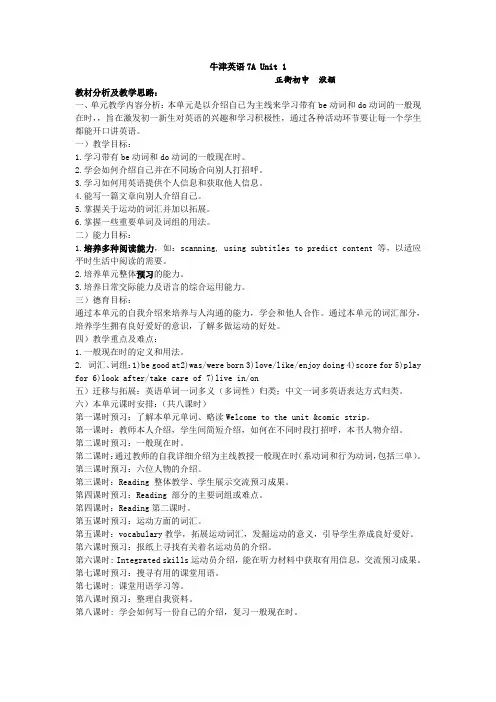
牛津英语7A Unit 1正衡初中洑颖教材分析及教学思路:一、单元教学内容分析:本单元是以介绍自已为主线来学习带有be动词和do动词的一般现在时,,旨在激发初一新生对英语的兴趣和学习积极性,通过各种活动环节要让每一个学生都能开口讲英语。
一)教学目标:1.学习带有be动词和do动词的一般现在时。
2.学会如何介绍自己并在不同场合向别人打招呼。
3.学习如何用英语提供个人信息和获取他人信息。
4.能写一篇文章向别人介绍自己。
5.掌握关于运动的词汇并加以拓展。
6.掌握一些重要单词及词组的用法。
二)能力目标:1.培养多种阅读能力,如:scanning, using subtitles to predict content等,以适应平时生活中阅读的需要。
2.培养单元整体预习的能力。
3.培养日常交际能力及语言的综合运用能力。
三)德育目标:通过本单元的自我介绍来培养与人沟通的能力,学会和他人合作。
通过本单元的词汇部分,培养学生拥有良好爱好的意识,了解多做运动的好处。
四)教学重点及难点:1.一般现在时的定义和用法。
2. 词汇、词组:1)be good at2)was/were born 3)love/like/enjoy doing 4)score for 5)play for 6)look after/take care of 7)live in/on五)迁移与拓展:英语单词一词多义(多词性)归类;中文一词多英语表达方式归类。
六)本单元课时安排:(共八课时)第一课时预习:了解本单元单词、略读Welcome to the unit &comic strip。
第一课时:教师本人介绍,学生间简短介绍,如何在不同时段打招呼,本书人物介绍。
第二课时预习:一般现在时。
第二课时:通过教师的自我详细介绍为主线教授一般现在时(系动词和行为动词,包括三单)。
第三课时预习:六位人物的介绍。
第三课时:Reading 整体教学、学生展示交流预习成果。
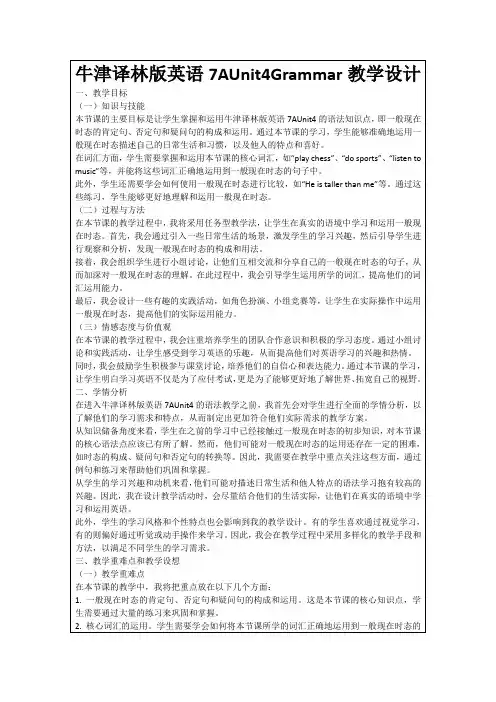
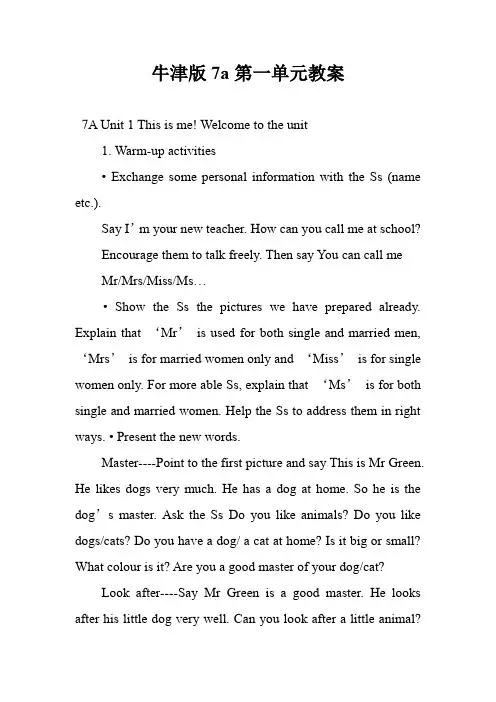
牛津版7a第一单元教案7A Unit 1 This is me! Welcome to the unit1. Warm-up activities• Exchange some personal information with the Ss (name etc.).Say I’m your new teacher. How can you call me at school?Encourage them to talk freely. Then say You can call meMr/Mrs/Miss/Ms…• Show the Ss the pictures we have prepared already. Explain that ‘Mr’is used for both single and married men, ‘Mrs’is for married women only and ‘Miss’is for single women only. For more able Ss, explain that ‘Ms’is for both single and married women. Help the Ss to address them in right ways. • Present the new words.Master----Point to the first picture and say This is Mr Green. He likes dogs very much. He has a dog at home. So he is the dog’s master. Ask the Ss Do you like animals? Do you like dogs/cats? Do you have a dog/ a cat at home? Is it big or small? What colour is it? Are you a good master of your dog/cat?Look after----Say Mr Green is a good master. He looks after his little dog very well. Can you look after a little animal?Do you give it some nice food? What do you give it to eat? Do you give it a warm room to sleep at night? Do you take it to the park for a walk everyday? Do you play with it? A good master should look after your dog/cat as your good friend.E-dog---- Say Look, there are two dogs here. Are they the same? No, they are different. Can you tell me what is the difference? Elicit the different places. (colour, size etc.) Anything else? Look at the yellow one. It’s a real dog. It can eat and sleep. What about the blue one? Can it eat? Can it sleep? No. Why? It’s not a real dog. It’s an e-dog. Do you have an e-dog at home? Instruction book---- Say Do you know how to look after an e-dog? Here is a book for you to read. Then you know how to look after the e-dog. This book is an instruction book.More examples can be given if time permits.• Show the comic strip to the Ss and give some questions for them to prepare. Then read the dialogue between two dogs for the Ss. I. Qs: 1) What’s the yellow dog’s name?2) What’s the e-dog’s name? 3) Who is the master? 4) Is Eddie happy in Picture 1? Why? 5) Is Eddie happy in Picture 4? Why? • Ask the Ss to repeat the dialogue after you, imitating your pronunciation and intonation. • Ss read the dialogue in pairs. Then act it out.2. Meeting new friends • Say Eddie has an e-dog. Its nameis Hobo. So Eddie is Hobo’s master. But do you know who is Eddie’s master? His master is Millie. • Show the picture and say We are meeting 6 new friends now. Millie is one of them. Listen carefully and find out. Read the dialogues for the Ss. • Read it again. This time they must try to remember the names as many as possible. Then collect the names from them. • Ss repeat after you. Pay attention to use different voices to differentiate the different characters. • Divide the class into pairs. Then they read the conversation. 3. Greetings• Say Look at Amy and Simon. When is it now? It’s in the morning. So they say good morning to each other. Look at the clocks and tell me the time. Present the different parts of the day.。
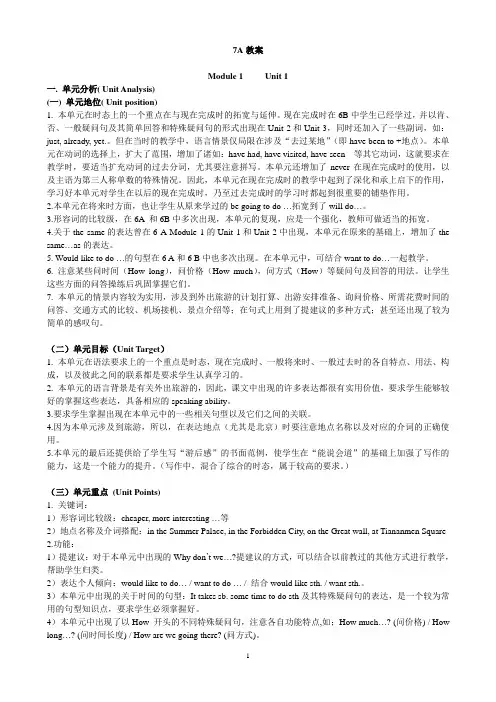
7A教案Module 1 Unit 1一. 单元分析( Unit Analysis)(一) 单元地位( Unit position)1. 本单元在时态上的一个重点在与现在完成时的拓宽与延伸。
现在完成时在6B中学生已经学过,并以肯、否、一般疑问句及其简单回答和特殊疑问句的形式出现在Unit 2和Unit 3,同时还加入了一些副词,如:just, already, yet.。
但在当时的教学中,语言情景仅局限在涉及“去过某地”(即have been to +地点)。
本单元在动词的选择上,扩大了范围,增加了诸如:have had, have visited, have seen 等其它动词,这就要求在教学时,要适当扩充动词的过去分词,尤其要注意拼写。
本单元还增加了never在现在完成时的使用,以及主语为第三人称单数的特殊情况。
因此,本单元在现在完成时的教学中起到了深化和承上启下的作用,学习好本单元对学生在以后的现在完成时,乃至过去完成时的学习时都起到很重要的铺垫作用。
2.本单元在将来时方面,也让学生从原来学过的be going to do …拓宽到了will do…。
3.形容词的比较级,在6A 和6B中多次出现,本单元的复现,应是一个强化,教师可做适当的拓宽。
4.关于the same的表达曾在6 A Module 1的Unit 1和Unit 2中出现,本单元在原来的基础上,增加了the same…as的表达。
5. Would like to do …的句型在6 A和6 B中也多次出现。
在本单元中,可结合want to do…一起教学。
6. 注意某些问时间(How long),问价格(How much),问方式(How)等疑问句及回答的用法。
让学生这些方面的问答操练后巩固掌握它们。
7. 本单元的情景内容较为实用,涉及到外出旅游的计划打算、出游安排准备、询问价格、所需花费时间的问答、交通方式的比较、机场接机、景点介绍等;在句式上用到了提建议的多种方式;甚至还出现了较为简单的感叹句。
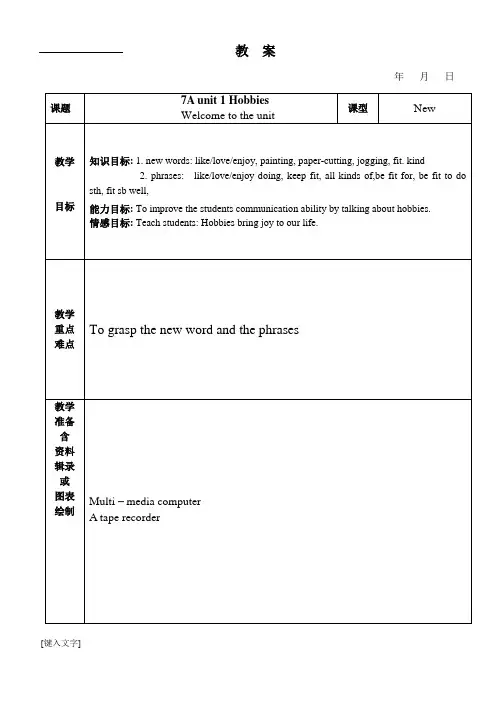
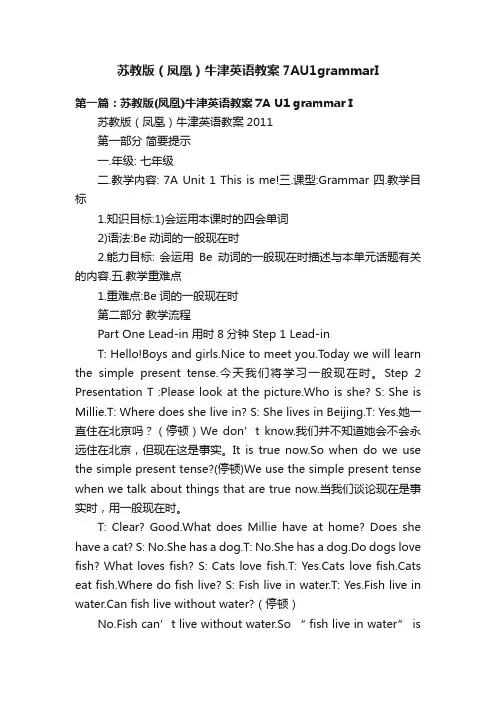
苏教版(凤凰)牛津英语教案7AU1grammarI第一篇:苏教版(凤凰)牛津英语教案7A U1 grammar I苏教版(凤凰)牛津英语教案2011第一部分简要提示一.年级: 七年级二.教学内容: 7A Unit 1 This is me!三.课型:Grammar 四.教学目标1.知识目标:1)会运用本课时的四会单词2)语法:Be动词的一般现在时2.能力目标: 会运用Be动词的一般现在时描述与本单元话题有关的内容.五.教学重难点1.重难点:Be词的一般现在时第二部分教学流程Part One Lead-in 用时8分钟 Step 1 Lead-inT: Hello!Boys and girls.Nice to meet you.T oday we will learn the simple present tense.今天我们将学习一般现在时。
Step 2 Presentation T :Please look at the picture.Who is she? S: She is Millie.T: Where does she live in? S: She lives in Beijing.T: Yes.她一直住在北京吗?(停顿)We don’t know.我们并不知道她会不会永远住在北京,但现在这是事实。
It is true now.So when do we use the simple present tense?(停顿)We use the simple present tense when we talk about things that are true now.当我们谈论现在是事实时,用一般现在时。
T: Clear? Good.What does Millie have at home? Does she have a cat? S: No.She has a dog.T: No.She has a dog.Do dogs love fish? What loves fish? S: Cats love fish.T: Yes.Cats love fish.Cats eat fish.Where do fish live? S: Fish live in water.T: Yes.Fish live in water.Can fish live without water?(停顿)No.Fish can’t live without water.So “ fish live in water” isalways true.鱼儿离不开水。
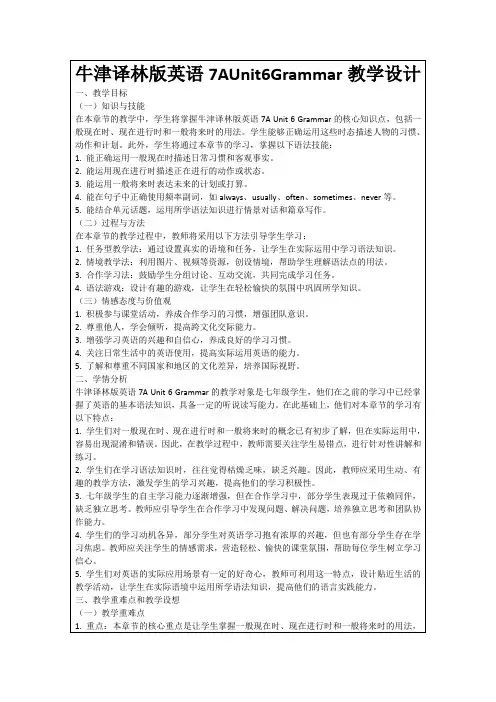
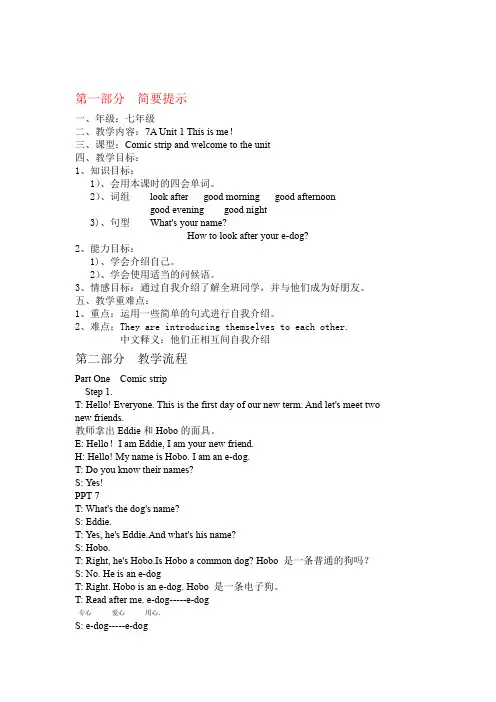
第一部分简要提示一、年级:七年级二、教学内容:7A Unit 1 This is me!三、课型:Comic strip and welcome to the unit四、教学目标:1、知识目标:1)、会用本课时的四会单词。
2)、词组look after good morning good afternoongood evening good night3)、句型What's your name?How to look after your e-dog?2、能力目标:1)、学会介绍自己。
2)、学会使用适当的问候语。
3、情感目标:通过自我介绍了解全班同学,并与他们成为好朋友。
五、教学重难点:1、重点:运用一些简单的句式进行自我介绍。
2、难点:They are introducing themselves to each other.中文释义:他们正相互间自我介绍第二部分教学流程Part One Comic stripStep 1.T: Hello! Everyone. This is the first day of our new term. And let's meet two new friends.教师拿出Eddie和Hobo的面具。
E: Hello!I am Eddie, I am your new friend.H: Hello! My name is Hobo. I am an e-dog.T: Do you know their names?S: Yes!PPT 7T: What's the dog's name?S: Eddie.T: Yes, he's Eddie.And what's his name?S: Hobo.T: Right, he's Hobo.Is Hobo a common dog? Hobo 是一条普通的狗吗?S: No. He is an e-dogT: Right. Hobo is an e-dog. Hobo 是一条电子狗。
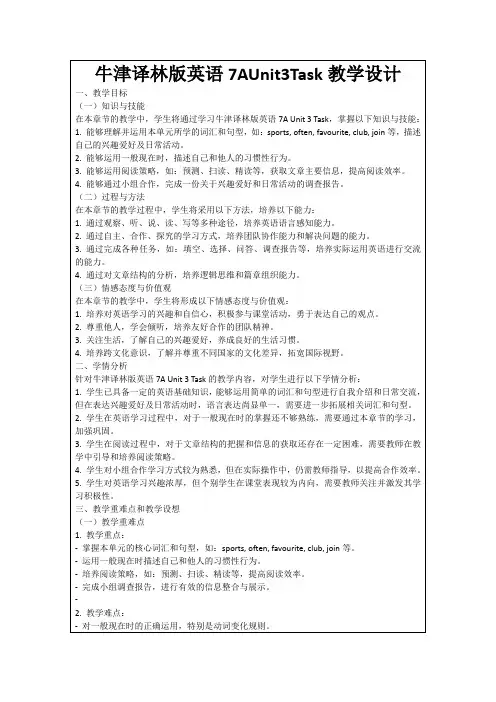
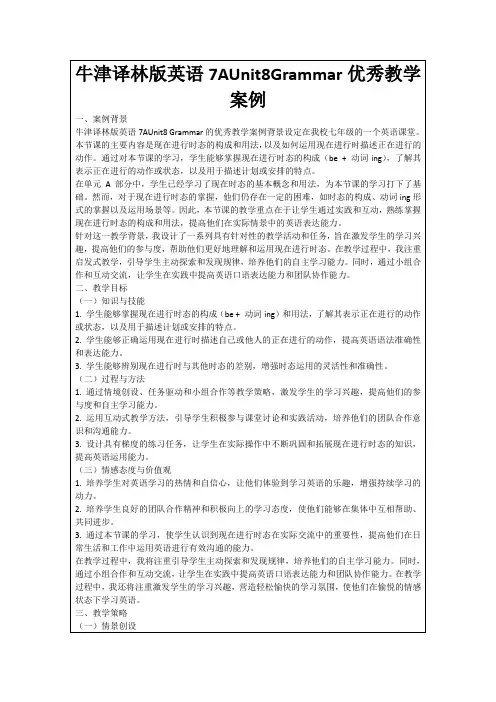
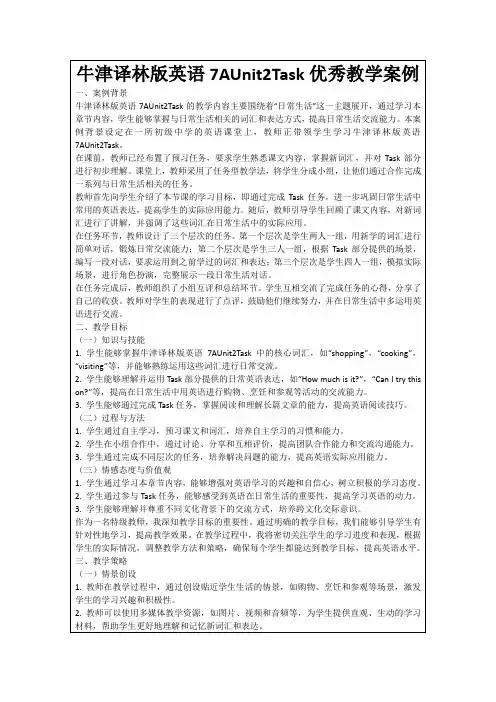
Unit 3 Friends from other countries教案(一)教学课题:《英语》(牛津上海版)7A Unit 3 Friends from other countries period 1(二)教学目标:1.Knowledge objective:To learn about different nationalities in Garden City.2.Ability objective:To practice speaking through dialogues.To practice listening through the look and read from the listening material. 3.Emotion objective:To inspire students know about a little more main names of the countries in the world. 4.Key and difficult objectives:(1)Key points: A. to use nouns to refer to people.B. to ask wh- questions to find out specific information(2)Difficult points: to teach the students how to read the numbers correctly(三)教学方法:Task-based learning(四)教学材料:1.The multi-media system2.Handout for the students.(Feedback 1I.Translation(写出下面词组)1.花园城市的外国人________________2.一个拥挤的城市__________________3.超过八百万人____________________4.举个例子________________________5.叫来自英语的人英国人____________II.Choose the best answer(选择正确的答案)1.---Have you bought any present for your friends from Japan?---Yes, I _______.A.doB. didC. haveD. had2.I’d like ______ some sweets.A.havingB. to haveC. haveD. had3.Let’s go for a trip _______ a sunny day.A.onB. inC. forD. at4.Where do Tim and Tom ______ from?esB. comeC. isD. are5.There is going to _______ a class meeting this afternoon.A.haveB. hasC. beD. isIII.Rewrite the sentences as required. (按要求改写句子)1.Mum has already bought much fruit. (改为否定句)Mum ________ _________ much fruit ________.2.He needs 100 yuan to buy the food. (改一般疑问句)_______ he ________ 100 yuan to buy the food?3.Tom’s new friend comes from the USA. (划线部分提问)_______ ________ Tom’s new friend come from?4.Sandy does exercise every morning. (划线部分提问)_______ _________ Sandy _______ every morning?5.There are five million people in Garden City. (划线部分提问)_______ ________ people are there in Garden City?后记:将表格放在前面教授,为文章做铺垫。
牛津初中英语教学案牛津初中英语(7A)Unit 2 My Day第一课时Welcome to the unit设计的基本理念:根据新课标培养学生自主、合作、探究精神、突出语言使用水平培养的理念而设计。
课型:对话、句型操练课1、技能目标:培养学生灵活使用本课所学词汇、句型来表述日常活动的对话水平。
2、知识目标:①重点单词:fun, sleep, a.m, p.m, homework, model, make, newspaper, film, mum, should, right.②重点短语:wake up, go to sleep, have assembly,…③重点句型:I get up at 6 a.m every morning.When do you get up?When do you go to school?What do you do after school?3、情感目标:通过学习谈论日常安排和活动之后,学生能够为自己制定一个合理的学习和生活的日常活动安排表。
4、策略目标:通过日常生活时间来描述自己或他人的日常活动,并学习使用词汇。
5、文化意识目标:时间表达,逻辑思维,做事有条理,时间观点强,珍惜光阴。
课堂教学模式:一学一练一测和任务型教学课前准备:1、准备一个钟。
2、教师或学生画一些日常活动的图片。
3、教师制作日常生活和学习的表格。
4、让学生预习新单词。
教学过程:Step 1: Revision.Review the names of meals and the different activities presented on page 19. Divide the class into groups of four. Brainstorm the topic of daily life activities. Ask Ss to draw an activity if they do not know the word in English.Step 2: Presentation.Talk to Ss about daily routines and activities.Say: I get up at 6 a.m in the morning.When do you get up? etcStep 3: Ask Ss to sort their activities into different sections:Leisure — Sports — Eating — school.Teacher tells Ss to write down the day and time when they typically do these activities. As you go around the class, provide help with vocabulary.Step 4: Each group writes the four lists on the board. Ss can copy the activities they want to include in their diary.Step 5: Work in pairs to talk about their partner’s diary. You can use the following sentence patterns:a. When do you go to school /…/ ?b. Do you go to school by bus /…/ ?c. What do you do after school /…/ ?Step 6: Learn Vocabulary.a. P23 Go through Part A and read the words and phrases correctly. Attention to their pronunciation.b. Ss complete the task and check answers. Encourage Ss to memorize the collocations Part B.c. Let Ss go through Part B and explain the context. Ask Ss to do the task on their own, then check answers. Ss correct any mistakes and the teacher explains something if necessary.d. Divide the class into pairs. Let Ss read the conversation and get some pairs to act it out.Step 7: Practice — task.课堂教学任务。
Unit 2 My DayThe 1st period Welcome to the unitⅠ.TEACHING AIMS AND DEMANDSUse the following words:1. fun, sleep, homework, model… activity, assembly…go to sleep, have assembly, have lessons, eat lunch…2. use the vocabulary in the lesson to talk about his own daily life.Ⅱ. TEACHING KEY AND DIFFICULT POINTSIt’s time to do/ for sthⅢ. TEACHING AIDS1. Multi-media computer2. Tape recorder.3. Some pictures.Ⅳ.TEACHING Methods1. Communicative teaching method2. Student-centered teaching3. “Tas k-based〞teaching method4. Activity-based teaching (individual work; pair work; group work; class work)Ⅴ. TEACHING ASSIGNMENT: One classⅥ. TEACHING PROCEDURESStep1. PresentationTalk about the daily life and activity.I get up at 6 a.m every morning. When do you get up? I have breakfast at 6.30 a.m.When do you eat breakfast/ lunch?Step2. PracticeAsk the students and say:T: When do you go to school?T: Do you go to school by bus?T: What do you do after school?Step3. Act out the dialogue.1.Ask the students to ask and answer the dialogue in groups:1). When do you get up?2). How many hours do you spend sleeping?How many hours do you spend eating?3). When do you get up?Step4. Homework1.Please memorize all the new words.2.Read the dialogue.The 2nd period Reading ⅠⅠ.TEACHING AIMS AND DEMANDS1.Get the Ss to guess the meaning according to the context.e English to describe school life by reading.Ⅱ. TEACHING KEY AND DIFFICULT POINTSHow to describe the Ss’ own school life.Ⅲ. TEACHING AIDS1. Multi-media computer2. Tape recorder.3. Some pictures.Ⅳ.TEACHING Methods1. Communicative teaching method2. Student-centered teaching3. “Task-based〞teaching method4. Activity-based teaching (individual work; pair work; group work; class work)Ⅴ. TEACHING ASSIGNMENT: One classⅥ. TEACHING PROCEDURESStep1. Discussion1. Simply describe the pictures of the own school.2. Discuss the problems in reading, and teach the new words.Step2. Reading1.Read the text one paragraph after another.Paragraph 11.What’s the name of the new school?2.Does Millie love her new school?3.Why does Millie love her classroom?Paragraph 24.Who is Millie’s best friend?5.What do Millie and Amy often do?Paragraph 36.Who is Mrs. Tang?7.What does Millie like doing?Paragraph 48.Where does Millie go after school every Tuesday?9.Who is a very good swimmer, Millie or Amy?2. Exercises: true or false( )lie e-mails Amy( )2.There are more than 1800 teachers at Millie’s school.( )lie sometimes plays games at lunchtime.( )4.The principal’s name is Mr Tang.( )lies favourite lessons are English and Maths.( )lie spends three hours a day doing her homework.( )lie goes to the reading club twice a week.( )lie is a member of the swimming club.( )lie doesn’t want Tommy to send her an e-mail.3. Fill in the blanksMillie’s new school is____ Beijing sunshine secondary school. She likes_____ classroom_____ she can see the ____. Amy is her best ______. They always ______ fun. They sit ____ the tree at lunchtime. They always ____ each other or _____ games together. Sometimes they buy _____ from the tuck shop. All her friends are ____ great!Step3. Practice1.Translate the following into English.1) 我们星期一早上八点钟开晨会。
牛津英语7A unit1教案Unit 1 This is meTeaching aims: To introduce oneselfTo use appropriate greetingsTeaching main points: greetingsTeaching difficulties: understanding of “master’ ‘instruction book’ and ‘look after’Teaching procedures:Step1 GreetingsStep2 RevisionStep3 Presentationintroduce myself. Say ‘Good morning, I am Miss Yu.Get Ss to talk in a non-intimidating environment, to start with simple greetingsExplain to Ss that they are meeting six Ss in Beijing. Ask them to look at the people in Part A and identify them by name.Ask: what are their names?Do they have English names? What are their names?Can you tell me the names of the boys and the girls?Step4 PracticePractise saying the names of the central characters.Step5 Reading.Read the conversation to the class using different voices.Read the sentences one at a timeSs read afterChoose six Ss to read one sentence each or divide the class into pairs. Then they read the conversation to each other.Step6 PracticeAsk Ss to do PartB1 alone.Ask Ss to do PartB2 in pairs to practise introducing oneselfHomework.Tell Ss to draw two scenes of people meeting each other. Ask them to draw speech bubble containing proper greetings.ReadingTeaching main points: I’m /This isSome important words & expressionsTeaching difficulties:To recognize the use of language in giving personal informationTo use personal pronounsTeaching procedures:Step 1 GreetingsStep2 RevisionReview key vocabulary according to the general ability of the classStep3 ReadingRead all the text to the class. Ss listen and follow the text in their booksAsk Ss to read the assigned profile on their own and underline the words they don’t know. Go through the words Ss have underlinedRead after the tapeStep 4 Read and writeRead the passage again, write the following on the board, for Ss to copy. Say find out five things about the assigned character.Name:________________Where does he/she live/come from?What does he/she like?What does he/she look like?Age:___________Step 5 ConsolidationB. New classmatesReview adj. and nouns that describe hair and the structure ‘to have’ as a brainstorming exercise. Ask Ss to look at the table on page5 and check their understanding by asking questions:Who likesfootball/basketball/swimming?Who has a cousin?Tell the Ss to read the passage again to check for specific information.C.Set this task as a quiz. Divide the class into two pairs and the pair who gets all the correct answers first is the winner.Ask Ss to correct the false statement.D. Getting to know the SsRevise some key words. Ask the class some open Qs:Who likes reading?Who likes to listen to music?Ask Ss to complete partD1 from memory. Ask ss to check their answers with their partners. Ask Ss to complete a profile of himself/herself in PartD2.Homework:Ask Ss to work in pairs and write profiles of each other.V ocabularyTeaching main points: 1 teach some nouns and verbs2. sports and equipmentTeaching difficulties: 1. to use verbs and nouns to talk about sports2. to describe different kinds of sportsTeaching procedure:Step1 Greetings and revisionStep2 PresentationTalk about sports with the classAsk Ss to complete Part A. Check the answers orallyTeach the words ‘football boots’ ‘swimsuit’ before they do Part BAsk Ss to complete the sentences on their own. Ask several Ss to read out their answersStep3 ConsolidationDraw the table on the boardSport: swimmingWhere; swimming poolSpecial clothes: swimsuitEquipment: gogglesTeam sport: NThen ask to add more columns for one sportAsk Ss to copy the table, tell them think of more sports to add to the table Homework:Ask Ss to make their own sentences about the sports that they write down in the table, e.g. I play badminton with a badminton racket.GrammarObjectives:1. To make positive and negative statements and ask Qs with the verb ‘to be’2. Learn to use the simple present tense to talkTeaching main points:1.Simple present tense2. How to add-s/-es / ies to the verbs3. Simple present tense of the verb ‘to be’Step1 Greetings & revisionStep2 PresentationGive Ss some examples in order to help them get to know the simple present tense e.g. Cats eat fish..Millie lives in Beijing.He plays football after school.Tell them that we use the simple present tense to talk about things thatare always trueare true nowwe do regularly (habits, jobs, school work ,etc.)Give Ss more examples and ask them to make more sentencesLet Ss complete Part A on their own. Check for correct pronunciation.Step 3 ConsolidationGo through the table with Ss, check their understanding by asking them to change other verbs.Ask Ss to complete Part B, go through the exercise with the whole class.Ask Ss to complete ‘Work out the rule!’Let Ss to read the sentences in Part C and complete them on their own.Ask Ss to compare and check their answers with a partner.Step 4 Simple present tense of the verb ‘to be’Go through the tables with Ss. Point out the contractions.Ss read the sentences on their own. In pairs, Ss compare and check answers. Go through the table on page11 with Ss.Ask Ss to read the sentences in part E, point out that they should use the correct forms of the verb ‘to be’Ask Ss to complete Part FHomework;ReciteTell Ss to write a letter to a pen friend about what they do at the weekend..Integrated skillsTeaching main points: 1. listening points2. learn some information about oneselfObjectives:1. To extract information from an article and obtain information from listening.2. To ask questions about personal information and respond Qs about oneselfTeaching procedure:Step 1 Greetings & RevisionStep 2 PresentationTell Ss to look at the headline of the newspaper article and the picture, say:A football player will play football. Then a lot of football players, they play football together. This is called a match. So when the football players play football together, it is called a football match. When the basketball players play basketball together, that is called a basketball match. Then the football players will go to a match. And this match is the biggest match of the football. That means all the best football players will go there and play. And this is called the World Cup. So it is the match for all the best football players. Right for the football players, so it is called the World Cup. Have a look at this picture.(Show the second picture) This is from last World Cup. What is this football player doing? He is kicking. He is kicking the football. Now if the football goes into the gate, we say he scores a goal.ask:Who do you think the person is ?What he does and which football team he plays for ?Write the following words: score, goal, match, team, the World Cup; teach the wordsNow Simon is going to complete the note. Can we help Simon complete the notes? First you should know Age Appearance Birthplace New team Next match Tell Ss to read the notes sheet before scanning the article for answers, ask them to find the answers in the newspaper article.Check their understanding of the article.A3Play the tapn from both the article and the note sheet in PartA1 on P12.Encourage the Ss to memorize the conversation so that they can respond automatically.Let Ss follow the text in the book.Tell the Ss to close their books and listen to me.Ask Ss to replace the underlined words with their own informationAsk Ss to practice the conversation in pairs and then change roles before they make up their own conversation. Step 3 PresentationTell Ss to write down frequently used words and phrases .Introduce the new word ‘borrow’. Ask Ss to work in pairs to exchange requests and responses as presented on P14 Check their understanding. Encourage Ss to repeat whole sentences from memory.Step 4 ExtensionTell Ss many more phrases they need to learn to understand the teacher expects :Listen carefullyListen to the tape/ recordingWork in pairsGet into pairs / groups of 3,4……Work on your ownNow it’s your turnOpen/Close your booksHomework1. Write an article about a football player or a basketball player.2. Finish ExercisesMain TaskObjectives: To write about oneself and introduce oneself to othersTeaching main points: learn to write about oneselfTeaching difficulties: learn how to organize ideas before writingTeaching procedure:Step 1 Greetings and revisionStep.2 PresentationTell the Ss that the class is preparing a handbook containing a profile of each student. Therefore, it is important to spend time writing their profiles as well as possible.Read the model profiles on P15. tell Ss to write something similar.Tell the Ss to read the outline on P16. Encourage Ss to include additional information if they canEncourage Ss to change the model phrases if they wish to make up their own sentences.In pairs, Ss read, check and correct their partners draft. Suggest improvements in the choice of words, spellings and structures.Ask for volunteers to read out their profiles to the class.Homework:Ask Ss to rewrite their personal profiles on a separate sheet of paper and add a picture of themselves. e twice, Ss need to extract informatio。
⽜津英语七年级第⼀学期7AUnit1教案设计(4课时)Module 1 RelationshipsUnit 1 Relatives in BeijingPeriod One教学⽬标1.To let students get some information from a letter.2.To encourage the students to speak English in class.3. To make them be more confident教学重点和难点(1) Key pointsa). The present future tense “be going to do sth”(2) Difficult points:a). Adjectives to make comparisonsb). Nouns and adverbs to show positionsc). How questions教学⽅法:Task-based learning教学材料1、The multi-media system.2、Handout for the students.教学过程:I. Pre-task preparation1. To sing an English songT: Class begins! Good morning, class.Ss: Good morning, Miss….T: Oh, it is a nice song. Shall we sing it? Ss: O.K.---- to sing a song.T: Good / Wonderful / well done!2. Look and learn(To introduce the topic of this unit by asking the following questions.a)Do you have any aunts/ uncles/ cousins…?T: They are all your relatives.b)Do you know the relationship between you and me?Learn the new words one by one. Finally let students be able to read and understand themTo read the new words as possible as frequency.a)relativeb)relationshipII. While-task procedures1. Read and answerShow the text on the computer.Let students read the letter by themselvesMr Li has got a letter from his brother, Weiming.Dear DavidWe haven’t seen each oth er for a long time. How are youand your family in Garden City?We would like to invite you to stay with us in Beijing inAugust. My children hav en’t seen their cousins before.They want to see them very much. They also want to takethem to those interesting places in Beijing.We will be very happy if y ou can come in August. It won’tbe very hot here.Please write to me as soon as possible.YoursWeimingQuestions:1.Where do Weiming and his family live?2.When would Weiming like to invite them to Beijing?3.Have Ben and Kitty seen their cousins before?4.What do Ben and Kitty’s cousins want to do?Answer:1.They live in Beijing.2.He would like to invite them to Beijing in August.3.No, they haven’t.4.They want to take Ben and Kitty to those interesting places in Beijing.2. Look and learnTo learn the following new words: (to ask the students toread and write them frequently, when they see the pictures,they can reflect what they are quickly.)a) What’s this?It’s an invitation.b) Why do people use invitations?invite sb. to… (give some sentences.)c) To compare the prices of the plane tickets and the train ticketsexpensive ----------- more expensivecheap-----------------cheaperd)travel agente) brochures3. Listen and read(To read the text and judge the following statements.)Mr Li: Look, Ben. I’ve got a letter from Uncle Weiming.He lives in Beijing. He has invited us to stay with his family in August.Ben: I haven’t seen my cousins before.Mr Li: Your uncle has sent us a photograph. These are your cousins, Simon and Lucy.Ben:How old are they?Mr Li:Simon is twelve and Lucy is ten.Ben:Are we going to travel to Beijing by plane?Mr Li: Perhaps, but plane tickets are very expensive.Ben:Let’s go by train. It’s c heaper and more interesting.Mr Li:That’s a good idea. Let’s talk to Mum and Kitty. I’m going to get some brochures from the travel agent.4. Read and judge1) Mr Li has got a letter from uncle Weiming.2) Weiming doesn’t live in Beijing.3)Weiming has invited us to stay with his family in September.4) Weiming is Ben’s uncle.5) Weiming sent a photo to them.6) Ben has three cousins: Simon, Lucy and Kitty.7) Simon is thirteen and Lucy is ten.ConsolidationWorkbook 7A, pages 1 and 3.后记:1. relationship和relatives学⽣在读的时候重⾳不准。